How to Help Children Overcome Fear


Written and verified by the psychologist Elena Sanz Martín
Fear is a normal and necessary emotion that manifests in children in various circumstances. However, when it becomes excessive or inappropriate, it can limit your life and cause serious problems. Parents’ actions will be essential to help their children overcome fear.
Adaptive fear and dysfunctional fear
Fear is one of the basic human emotions, which plays a fundamental role in our lives. In this regard, it alerts you to possible dangers and helps you to react to them, ensuring your survival. Despite the fact that it’s an unpleasant emotion that makes you feel uncomfortable and you don’t like to experience, fear is necessary. It’s adaptive and has a beneficial function.
The problem arises when fear becomes dysfunctional and begins to alert you to situations that aren’t really dangerous. When fear becomes excessive, irrational, or persistent over time, it can condition children’s lives, forcing them to flee from harmless situations.
It’s normal for a child to feel certain momentary nerves when they’re interacting with a stranger for the first time. But if this fear becomes true anguish or remains a constant in their social relationships for years, it’ll limit them.

Evolutionary fears
Children go through a series of evolutionary stages that are characterized by specific fears that are common to all children of the same age. In this regard, little ones fear loud noises, the absence of their attachment figures, and strangers.
Later on, they fear animals, darkness, physical damage, and natural phenomena, such as storms. By the age of six, fear of paranormal beings and horror characters begins, as well as fear of illness and of something happening to their loved ones.
From the age of seven onwards, children begin to experience more social fears, such as fear of embarrassment, not being accepted, or failing an exam. In addition, the fear of death or of being attacked may manifest.
These fears are part of healthy development and gradually disappear. However, if these fears persist or manifest with disabling anxiety, you should seek help.
Helping children overcome fear
Despite being a normal and beneficial phenomenon, fear can be unpleasant and intimidating for children. Thus, your role will be to guide them and teach them tools to face their fears and come out stronger. Below, we share some strategies you can apply to help your children overcome fear.
Deal with the situation with understanding and ease
As strange or insignificant as your child’s fear may seem, don’t downplay or overlook it, as you’ll invalidate their feelings. Nor is it advisable for you to scold or embarrass your child.
Show yourself available and interested in talking to them and learning how they feel. Discuss together what they’re scared of and help them to analyze the situation in a rational way, as much as possible.

Encourage a coping attitude to help children overcome fear
Experts advise parents against overreacting to their child’s fear. Don’t make the situation the center of attention or make exceptional concessions to keep your child away from what scares them at all costs. Take it naturally and, above all, encourage them not to run away from their fears but to gradually face them instead.
Although running away from what they fear can provide momentary relief, in the long run, their fear will worsen. Help your child increasingly approach the feared situation. Never force them to do so. Instead, positively reinforce their courageous behaviors. Emotional staging is a very useful technique in this step.
Provide tools to overcome fear
Explain that it’s normal to feel fear sometimes and that it can be overcome. Be a role model by showing them how you deal with fearful situations yourself. Also, teach them strategies to regulate their fear, such as simple relaxation techniques, listening to music, or keeping your mind busy thinking about pleasant things.
Fear is a normal and necessary emotion that manifests in children in various circumstances. However, when it becomes excessive or inappropriate, it can limit your life and cause serious problems. Parents’ actions will be essential to help their children overcome fear.
Adaptive fear and dysfunctional fear
Fear is one of the basic human emotions, which plays a fundamental role in our lives. In this regard, it alerts you to possible dangers and helps you to react to them, ensuring your survival. Despite the fact that it’s an unpleasant emotion that makes you feel uncomfortable and you don’t like to experience, fear is necessary. It’s adaptive and has a beneficial function.
The problem arises when fear becomes dysfunctional and begins to alert you to situations that aren’t really dangerous. When fear becomes excessive, irrational, or persistent over time, it can condition children’s lives, forcing them to flee from harmless situations.
It’s normal for a child to feel certain momentary nerves when they’re interacting with a stranger for the first time. But if this fear becomes true anguish or remains a constant in their social relationships for years, it’ll limit them.

Evolutionary fears
Children go through a series of evolutionary stages that are characterized by specific fears that are common to all children of the same age. In this regard, little ones fear loud noises, the absence of their attachment figures, and strangers.
Later on, they fear animals, darkness, physical damage, and natural phenomena, such as storms. By the age of six, fear of paranormal beings and horror characters begins, as well as fear of illness and of something happening to their loved ones.
From the age of seven onwards, children begin to experience more social fears, such as fear of embarrassment, not being accepted, or failing an exam. In addition, the fear of death or of being attacked may manifest.
These fears are part of healthy development and gradually disappear. However, if these fears persist or manifest with disabling anxiety, you should seek help.
Helping children overcome fear
Despite being a normal and beneficial phenomenon, fear can be unpleasant and intimidating for children. Thus, your role will be to guide them and teach them tools to face their fears and come out stronger. Below, we share some strategies you can apply to help your children overcome fear.
Deal with the situation with understanding and ease
As strange or insignificant as your child’s fear may seem, don’t downplay or overlook it, as you’ll invalidate their feelings. Nor is it advisable for you to scold or embarrass your child.
Show yourself available and interested in talking to them and learning how they feel. Discuss together what they’re scared of and help them to analyze the situation in a rational way, as much as possible.

Encourage a coping attitude to help children overcome fear
Experts advise parents against overreacting to their child’s fear. Don’t make the situation the center of attention or make exceptional concessions to keep your child away from what scares them at all costs. Take it naturally and, above all, encourage them not to run away from their fears but to gradually face them instead.
Although running away from what they fear can provide momentary relief, in the long run, their fear will worsen. Help your child increasingly approach the feared situation. Never force them to do so. Instead, positively reinforce their courageous behaviors. Emotional staging is a very useful technique in this step.
Provide tools to overcome fear
Explain that it’s normal to feel fear sometimes and that it can be overcome. Be a role model by showing them how you deal with fearful situations yourself. Also, teach them strategies to regulate their fear, such as simple relaxation techniques, listening to music, or keeping your mind busy thinking about pleasant things.
All cited sources were thoroughly reviewed by our team to ensure their quality, reliability, currency, and validity. The bibliography of this article was considered reliable and of academic or scientific accuracy.
- Grande, M. D. P. (2000). El miedo y sus trastornos en la infancia. Prevención e intervención educativa. Aula, 12.
- Mármol, A. G. (2013). La relajación en niños: principales métodos de aplicación. EmásF: revista digital de educación física, (24), 35-43.
This text is provided for informational purposes only and does not replace consultation with a professional. If in doubt, consult your specialist.








